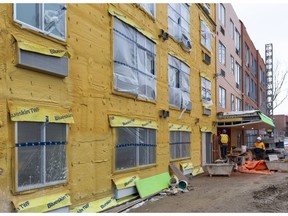Some elements narrow down what the province has in mind: they will be low-rise ownership homes and the cost will be “attainable.”
Published Apr 04, 2024 • Last updated 5 hours ago • 5 minute read
 Bricklayers put up bricks in a modular low-rise project in London, Ontario. The province wants to see the City of Ottawa identify land for modular housing within the municipality. Photo by Mike Hensen /THE LONDON FREE PRESS / POSTMEDIA NETWORK
Bricklayers put up bricks in a modular low-rise project in London, Ontario. The province wants to see the City of Ottawa identify land for modular housing within the municipality. Photo by Mike Hensen /THE LONDON FREE PRESS / POSTMEDIA NETWORK
The province has asked the City of Ottawa to identify surplus land on which to build modular housing as part of its $543-million “new deal” with the municipality.
As one of its “core commitments” to the deal, the city is to develop modular home ownership sites on two pieces of surplus land the province has asked the city to identify. The deadline to decide on that land and “lead the development of two ready surplus municipal sites” is the end of December.
Advertisement 2
This advertisement has not loaded yet, but your article continues below.
THIS CONTENT IS RESERVED FOR SUBSCRIBERS ONLY
Subscribe now to read the latest news in your city and across Canada.
Exclusive articles from Elizabeth Payne, David Pugliese, Andrew Duffy, Bruce Deachman and others. Plus, food reviews and event listings in the weekly newsletter, Ottawa, Out of Office.Unlimited online access to Ottawa Citizen and 15 news sites with one account.Ottawa Citizen ePaper, an electronic replica of the print edition to view on any device, share and comment on.Daily puzzles, including the New York Times Crossword.Support local journalism.
SUBSCRIBE TO UNLOCK MORE ARTICLES
Subscribe now to read the latest news in your city and across Canada.
Exclusive articles from Elizabeth Payne, David Pugliese, Andrew Duffy, Bruce Deachman and others. Plus, food reviews and event listings in the weekly newsletter, Ottawa, Out of Office.Unlimited online access to Ottawa Citizen and 15 news sites with one account.Ottawa Citizen ePaper, an electronic replica of the print edition to view on any device, share and comment on.Daily puzzles, including the New York Times Crossword.Support local journalism.
REGISTER / SIGN IN TO UNLOCK MORE ARTICLES
Create an account or sign in to continue with your reading experience.
Access articles from across Canada with one account.Share your thoughts and join the conversation in the comments.Enjoy additional articles per month.Get email updates from your favourite authors.
Sign In or Create an Account
or
Article content
Article content
There’s a lot that is still unanswered about what this means for potential homeowners, but three elements narrow down what the province has in mind: the homes will be ownership units, they will be low-rise and the cost will be “attainable.”
Here’s what we know so far:
What is modular housing?
Essentially, modular housing is prefabricated housing, built off-site in a factory and transported to the building site to be assembled. Most people are familiar with single-family modular homes, usually transported from the factory to a lot provided and serviced by the buyer.
The main difference between modular houses and conventionally built houses is the construction and delivery process, according to the province’s definition.
“With modular construction, three-dimensional modules are constructed in a factory and then moved to the site, usually on a flatbed truck. After they arrive on-site, the modules are placed on a foundation, connected to each other, and then fully finished.”
Tiny homes can be modular. So can apartment buildings. In larger projects, the modules are stackable, to create multi-unit buildings. Some projects are also hybrid, meaning certain elements are prefabricated and others are built on the site.
Advertisement 3
This advertisement has not loaded yet, but your article continues below.
Article content
 Premier Doug Ford appeared at the Mayor’s Breakfast Series last week with Ottawa Mayor Mark Sutcliffe. Photo by Justin Tang /The Canadian Press
Premier Doug Ford appeared at the Mayor’s Breakfast Series last week with Ottawa Mayor Mark Sutcliffe. Photo by Justin Tang /The Canadian Press
The province is big on modular housing. Why?
With the 2022 More Homes Built Faster Act, the province was looking to leverage surplus or under-utilized lands as well as building technology to meet its goal of building at least 1.5 million new homes by 2031.
Last November, the province convened its first annual housing forum to discuss how to meet those goals in the face of high interest rates, labour shortages and inflation on the cost of building materials.
The government is developing a modular housing framework to help meet housing demands and position the province’s construction industry to be a leader in innovative housing construction, said Paul Calandra, the Minister of Municipal Affairs and Housing.
“We intend to use a ready-to-go Request for Qualification process which is a transparent approach to identify and pre-qualify companies interested in modular housing construction,” he said.
Premier Doug Ford has expressed enthusiasm for modular housing. In December in a video on X, Ford built a gingerbread house out of a kit while extolling the efficiency of building modular homes.
Advertisement 4
This advertisement has not loaded yet, but your article continues below.
Article content
“To tell you the truth, the modular homes are probably easier to build than the gingerbread house,” said Ford as he was glueing the pieces together with icing.
Do other cities have modular housing initiatives?
There are examples all over the province, built for various reasons and different markets.
Toronto approved the construction of its first 250 modular homes on city-owned sites in 2020 and 2021. Since then, Toronto has completed 216 modular homes and has committed to building 1,000 new modular homes.
In Hamilton, a modular affordable rental housing development with 24 studio apartments and shared amenities such as a communal room and a laundry room was built in a former parking lot.
Some projects are temporary measures.
Peterborough has opened a “modular bridge housing community,” consisting of 50 individual cabins with a communal washroom-shower facility and a service hub for support agencies. It is operated by the Elizabeth Fry Society.
The Niagara region has announced a temporary 50-bed modular homeless shelter in downtown St. Catharines. It will remain open for about two years until a permanent shelter is ready.
Advertisement 5
This advertisement has not loaded yet, but your article continues below.
Article content
Are there any examples of multi-unit lowrise modular buildings constructed by Ottawa builders?
Jason Burggraaf, executive director of the Greater Ottawa Home Builders’ Association, doesn’t know of any local builders who have built or are considering large-scale modular projects.
“But that doesn’t mean there aren’t any,” he said. “I don’t know of any projects that have been built to these specifications, or similar, but that doesn’t preclude them from being done,” he said.
Like mixed-income or affordable projects, it would have to be something a builder takes on specifically because they want to do that type of project, said Burggraaf. If a project allows for panelization or component building, that will open up opportunities for most large-scale builders.
 Jason Burggraaf, executive director of the Greater Ottawa Home Builders Association. Photo by ERROL MCGIHON /Postmedia
Jason Burggraaf, executive director of the Greater Ottawa Home Builders Association. Photo by ERROL MCGIHON /Postmedia
The province is looking for ‘attainable’ modular housing. What does that mean?
That’s unclear. The province uses the word “attainable” often, but has not defined what it means. The city is working on a definition with the province, said city manager Wendy Stephanson.
According to the Canada Mortgage and Housing Corporation (CMHC), the narrow definition means housing that conforms to the standard definition of “affordable” housing, which means housing consumes no more than 30 per cent of a household’s gross, pre‐tax income.
Advertisement 6
This advertisement has not loaded yet, but your article continues below.
Article content
CMHC’s broader definition is that the cost allows people to be housed and move to other levels of the local market as their needs change — for example, a couple who live in a rented apartment buying a townhouse after they have children.
Policy-wise, the government has tied the idea of attainable to modular, said Burggraaf.
While it hasn’t been officially defined, “attainable” is generally assumed to be about 90 per cent of average market rent, while “affordable” is typically assumed to be at 80 per cent of average market rent or better, he said.
What are some likely sites for a modular housing project in Ottawa?
That’s also unclear. Stephanson told councillors the city is looking at identifying sites, but did not name any.
Some are already concerned about the parameters of the deal. Some candidate sites for low-rise modular housing might be better suited for more dense housing, said Kitchissippi ward Coun. Jeff Leiper.
“We should be looking at mid-rise and high-rise,” he told Stephanson.
Our website is your destination for up-to-the-minute news, so make sure to bookmark our homepage and sign up for our newsletters so we can keep you informed.
Recommended from Editorial

Presenting the details of Ottawa’s ‘historic’ $543M deal with province

Mayor Mark Sutcliffe defends decision to run London Marathon while in U.K. with Ottawa Tourism
Article content
>>> Read full article>>>
Copyright for syndicated content belongs to the linked Source : OttawaCitizen – https://ottawacitizen.com/news/local-news/what-is-modular-housing































